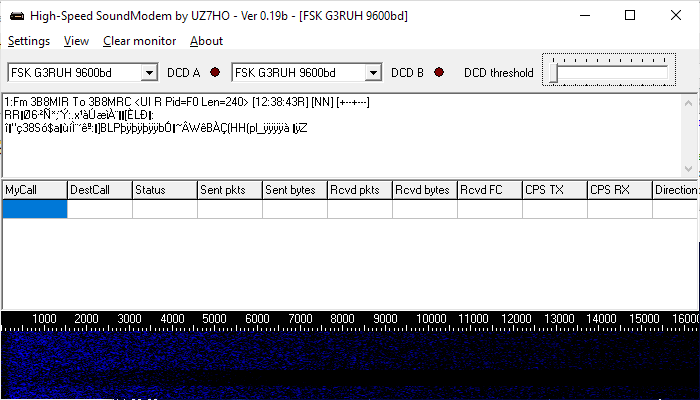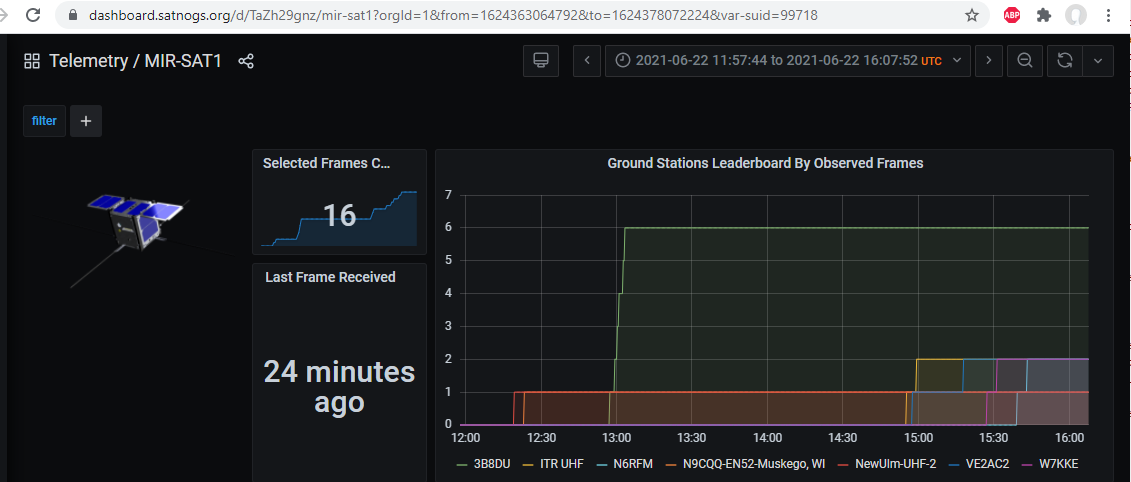

Mir-Sat-1 was deployed from the ISS this morning by JAXA. I tried to receive it on the first pass over North America about an hour later. I am without a proper antenna and rotator at the moment, so I stood on my back roof holding an arrow antenna and pointing it in the general direction of the ISS. I had my main PC in the shack setup to do the decoding, so I mirrored the screen to my Microsoft Surface using AnyDesk. That way I could keep an eye on SatPC32 and the decoder. The antenna fed into my homebrew pre-amp and then down into the FT-736R. That fed my 9600bd TNC which was connected to the Pacsat Ground station decoder.
I had little faith this would work, especially with me standing on the roof and unable to tune the radio. The predicted Doppler is likely off, so I was unlikely to get a frame. As a precaution I split the coax and fed a Funcube Dongle SDR in parallel with the FT-736R. That fed HDSDR which I setup to record the pass.
I thought I heard one frame while standing on the roof, my arm complaining about the weight of the arrow and the pre-amp but I did not see any decodes in the decoder.
Looking at the recording after the pass I realized I had recorded the wrong frequency or at least the center frequency was wrong. HDSDR does not correct the center frequency even when tuning from SatPC32. So I corrected the center frequency and set everything up for the second pass 90 mins later.
Standing on the roof again, luckily in very mild weather with 18C and no sun, I heard a definite frame. I could see it clearly in the HDSDR waterfall! This was great. But no decode. I carefully tracked the rest of the pass, wishing I had a camera tripod or something else to hold the antenna as my arm was definitely tired.
After the pass I replayed the recording into hs_soundmodem. But no decode. Hmm, the frame looked decent. Not strong but surely good enough to decode. I played almost endlessly with the settings and managed to get a decode with HDSDR set to 10.9kHz bandwidth and a very low volume stetting. hs_soundmodem needed the DCD threshold set very low.

I fed the data into the Pacsat Ground station and of course got nothing. Grrr. I was only decoding one frame so it is not a complete beacon. Mir-Sat-1 beacons consist of two frames! I quickly modified my code to print out what I was receiving. It was the second frame of the beacon. Note that even though PacSatGround was not printing the beacon on the screen it was still forwarding the frame to SatNogs and I could see my Ground Station name on their leaderboard!

Note that my ground station is showing up as VE2AC2 because the Pacsat groundstation truncates VE2/AC2CZ to fit into a packet frame. I should probably fix that too because we can send a long name to SatNogs with no issue.

A big congratulations to the Mir-Sat-1 team. Their spacecraft seems to be alive in orbit. Which is a monumental achievement. I look forward to helping with further testing. I will be releasing a new version of PacSatGround shortly that better shows the received beacons.
Here is a copy of the recording if you want to try to decode this. But note this is a difficult frame to decode.
Enter Comments Here:
| On: 07/18/21 12:12 Vickram - 3B8BBD said: |
Hello Chris, I have been stuggling to decode MIR-SAT1. May be I can get some help from you. Right now I can decode FS3 using PacSatGround. But when it come to MIR SAT 1 nothing. 3B8DU also tried to help but in vain. Is there any setting for the sound in windows which is piping to the modem. I noticed that windows output the sound at 44100 Hz. Does this cause a problem? Any help will be much appreciated. |
| On: 07/18/21 15:15 Chris G0KLA said: |
Hi Vickram, Mir-Sat-1 is tricky to decode it seems. I have had that report from others too. Windows does default to 44100Hz and it can be a problem. Make sure the sound card you are using is set to 48000Hz as well as the modem software. 44100Hz does not divide evenly into any modern data rate, unlike 48000. It can cause subtle timing issues. If everything is set to 44100 then it is probably OK. If the soundcard is at 44100 and the modem is at 48000 then that distorts the signal significantly. By the way, we have Sony and their Compact Disk standard to thank for 44100. If Decca had been successful then Compact Disks would have been at 48000 bps. |
| On: 07/24/21 11:11 Vickram -3B8BBD said: |
Hi Chris, Sorry for late reply, yes, setting all the sound at the same sample rate does indeed help. the sound as mentioned was by default at 44100 Hz, When changed to 48000 Hz (DVD quality) the magic happened. MIR SAT 1 was decoded. Also i placed the SDR sample rate to 2000 at 48000 Hz. Thx Chris. |
| On: 07/24/21 18:18 Chris G0KLA said: |
Great to hear Vickram. Well done! |
| On: 08/15/23 10:10 said: |
Copyright 2001-2021 Chris Thompson
Send me an email